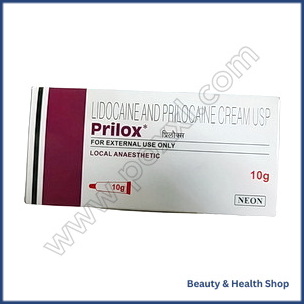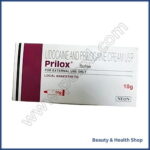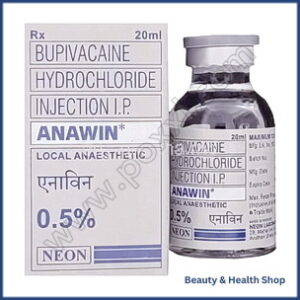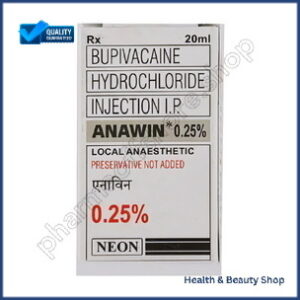ADDICTION
ALCOHOL DEPENDENCE
QUIT SMOKING
ALLERGY
ANTI FUNGAL
FUNGAL INFECTION
FUNGAL NAIL INFECTIONS
ANTI-REJECTION DRUGS
ANTI WORM
ANTIBIOTIC
BACTERIAL INFECTIONS
ARTHRITIS
GOUT
OSTEOARTHRITIS
RHEUMATOID ARTHRITIS
BLOOD
LOW PLATELET COUNT
THROMBOPHLEBITIS
VARICOSE VEINS
COLON
ANAL FISSURE
PILES
ULCERATIVE COLITIS
DIABETES CARE
DIABETES INSIPIDUS
DIABETES TYPE
DIABETIC FOOT ULCERS
GLUCOSE MONITOR
EYES/EAR CARE
DRY EYES
EYE CARE
EYE EXAMINATION
EYE INFECTION
EYE LASHES
EYE PAIN
GLAUCOMA
OCULAR HYPERTENSION
UVEITIS
FEVER CARE
MALARIA
RHEUMATIC FEVER
TYPHOID FEVER
GASTROINTESTINAL
ACIDITY
CONSTIPATION
CROHN'S DISEASE
DIARRHOEA
GALLBLADDER STONES
INTESTINAL ULCERS
IRRITABLE BOWEL SYNDROME
MOTION SICKNESS
NAUSEA
Prilox Cream (Prilocaine/Lidocaine)
| Active Ingredient (Generic Name): | Prilocaine/Lidocaine |
|---|---|
| Indication: | local anesthesia |
| Manufacturer: | Neon Laboratories |
| Packaging: | 5 gm in one tube |
| Strength: | 5gm |
From: $31.00
Prilox Cream, with Prilocaine and Lidocaine, is a topical anesthetic used for numbing during skin procedures, enhancing comfort and precision. It swiftly alleviates discomfort by blocking nerve signals to reduce pain sensation. Applied as directed before surgeries or cosmetic procedures, it numbs the area within minutes. Side effects like redness or itching may occur. Remember to wash the area before applying, avoid sensitive areas, and stick to dosage instructions. Consider consulting for off-label uses. Various brand options are available. Purchase from authorized sources, follow safety precautions, and perform a patch test for allergies. For more details on usage, benefits, and safety tips, explore further.
To begin exploring the benefits of Prilox Cream, start by understanding its primary function in providing local anesthesia for various skin procedures. Prilox Cream, containing the active ingredients Prilocaine and Lidocaine, works by numbing the skin to reduce pain and discomfort during minor surgical or cosmetic procedures like skin biopsies, tattoo removal, or laser therapy.
By applying Prilox Cream topically to the targeted area, it temporarily blocks nerve signals in the skin, making the procedure more tolerable for the patient. This local anesthesia effect allows medical professionals to perform procedures with greater precision and comfort for the patient.
It’s important to adhere to the instructions provided by your healthcare provider when using Prilox Cream to guarantee safe and effective numbing before the intended skin procedure. Understanding how Prilox Cream functions to provide local anesthesia is essential in maximizing its benefits for various dermatological and cosmetic treatments.
Topical Numbing Effects
Experiencing a numbing sensation upon application, Prilox Cream swiftly alleviates discomfort for patients undergoing skin procedures. This topical anesthetic contains prilocaine and lidocaine, which work together to block nerve signals in the skin, reducing pain sensation.
Once applied, Prilox Cream numbs the targeted area within minutes, allowing medical procedures like minor surgeries, skin biopsies, or laser treatments to be performed with minimal discomfort. The numbing effect lasts for a sufficient duration, ensuring patient comfort throughout the procedure.
Prilox Cream’s quick onset of action makes it a valuable tool in dermatology and other medical fields requiring localized pain relief. It’s essential to follow the prescribed dosage and application instructions to prevent any adverse effects.
Why is this medication prescribed?
When skin procedures require pain relief, Prilox Cream is prescribed for its quick numbing effects, provided by the combination of prilocaine and lidocaine to block nerve signals in the skin.
Prilocaine and lidocaine are local anesthetics that work by inhibiting the transmission of pain signals from the nerves to the brain. This cream is commonly used to numb the skin before medical procedures such as injections, skin grafts, or minor surgical procedures.
By applying Prilox Cream to the skin surface, it helps to alleviate discomfort and pain during these procedures, making them more tolerable for patients. The numbing effect of Prilox Cream sets in rapidly, usually within minutes after application, allowing healthcare providers to perform the necessary procedures without causing significant pain or discomfort to the patient.
How should this medicine be used?
For best results, apply Prilox Cream as directed by your healthcare provider. Before using the cream, wash and dry the affected area thoroughly. Apply a thin layer of the cream to the skin, covering the entire area that needs numbing. Massage the cream gently into the skin until it’s absorbed. Be careful not to get the cream in your eyes, nose, mouth, or any open wounds. After applying the cream, wash your hands thoroughly to avoid inadvertently spreading it to unintended areas.
The amount of Prilox Cream needed will depend on the area being treated and your healthcare provider’s instructions. Don’t bandage or wrap the treated area unless instructed to do so by your provider. Avoid applying heat to the treated area, as this can increase the absorption of the medication into the bloodstream. If you have any questions about how to use Prilox Cream properly, consult your healthcare provider for clarification.
Other uses for this medicine
If you’re uncertain about other potential uses for Prilox Cream, it’s important to consult with your healthcare provider for guidance and information. Prilox Cream, containing Prilocaine and Lidocaine, is primarily used as a topical numbing agent to reduce pain or discomfort during certain medical procedures like injections, skin surgeries, or minor dermatological procedures. However, there are other off-label uses that your healthcare provider may consider based on your specific condition.
One common off-label use of Prilox Cream is for managing discomfort or pain associated with conditions like hemorrhoids, anal fissures, or insect bites. It may also be utilized to alleviate pain from minor burns, cuts, or abrasions. In some cases, healthcare providers may recommend Prilox Cream to ease discomfort during laser hair removal procedures or tattoo applications.
It’s important to remember that using Prilox Cream for off-label purposes should only be done under the guidance and supervision of a qualified healthcare professional to ensure safe and effective application. Always follow your healthcare provider’s instructions carefully to minimize risks and maximize the benefits of this medication.
What special precautions should I follow?
Before using Prilox Cream, it’s important to check for any allergies you may have to its components. Allergic reactions can be serious and may require immediate medical attention.
If you experience any unexpected symptoms after applying the cream, seek medical help promptly.
Check for Allergies First
Prior to using Prilox Cream, make sure you perform an allergy check to prevent any adverse reactions. Here are some steps to follow:
-
Conduct a patch test: Apply a small amount of Prilox Cream on a small area of skin and observe for any signs of irritation.
-
Consult with a healthcare provider: Discuss any known allergies or previous reactions to local anesthetics.
-
Inform about other medications: Notify your healthcare provider about any current medications to avoid potential drug interactions.
-
Monitor for symptoms: Keep an eye out for redness, swelling, itching, or any other unusual reactions after applying the cream.
What special dietary instructions should I follow?
Consider incorporating a balanced diet rich in fruits and vegetables while using Prilox Cream to optimize its effectiveness. Eating a variety of colorful fruits and vegetables can provide essential vitamins and minerals that support overall health, potentially enhancing the healing process of your skin. Additionally, staying hydrated by drinking an adequate amount of water daily can help maintain skin hydration, which may contribute to the cream’s efficacy.
While there are no specific dietary restrictions associated with using Prilox Cream, it’s advisable to avoid consuming excessive amounts of caffeine or alcohol. These substances can potentially impact your skin’s sensitivity and may interfere with the numbing effects of the cream. Maintaining a balanced diet and healthy lifestyle can positively influence your body’s response to the medication and aid in the overall treatment process.
Remember to consult with your healthcare provider or a nutritionist if you have specific dietary concerns or require personalized recommendations while using Prilox Cream.
What should I do if I forget a dose?
If you forget a dose of Prilox Cream, apply it as soon as you remember, ensuring not to double up on the medication to make up for the missed dose. It’s important to maintain the prescribed schedule to achieve the desired effects of the cream consistently.
Missing a dose may affect the effectiveness of the medication in providing relief from discomfort or pain. If you realize you have missed a dose close to the time of your next scheduled application, skip the missed dose and continue with your regular dosing schedule. However, don’t apply extra cream to make up for the missed dose as this can lead to an overdose or unwanted side effects.
If you have any concerns about missing a dose or if you frequently forget to apply the cream as directed, it’s advisable to consult with your healthcare provider for guidance on how to proceed. Consistency in medication application is essential for best results.
What side effects can this medication cause?
Prilox Cream may cause some side effects, which can be serious. You should monitor for persistent symptoms and contact your doctor immediately if you experience any concerning signs or symptoms.
It’s crucial to be aware of potential side effects and seek medical advice promptly if needed.
Monitor for Persistent Symptoms
Be watchful for any adverse reactions that may arise while using Prilox Cream. It’s vital to monitor for persistent symptoms to guarantee your well-being. Here are some common side effects to watch out for:
- Skin irritation or redness at the application site
- Numbness or tingling in the treated area
- Itching or rash on the skin
- Swelling or inflammation at the site of application
If you notice any of these symptoms persisting or worsening, it’s essential to consult your healthcare provider for further guidance. Monitoring for these side effects can help in managing your treatment effectively and ensuring a safe experience with Prilox Cream.
Some side effects can be serious. If you experience any of the following symptoms, call your doctor immediately:
Serious side effects of Prilox Cream may include severe allergic reactions that require immediate medical attention. If you experience any of the following symptoms, call your doctor immediately:
- Severe skin rash or hives
- Swelling of the face, lips, or throat
- Difficulty breathing or swallowing
- Fast or irregular heartbeat
These symptoms could indicate a severe allergic reaction to Prilox Cream, which requires prompt medical intervention. It’s essential to seek immediate medical help if you encounter any of these signs while using this medication to safeguard your safety and well-being.
What should I know about the storage and disposal of this medication?
When storing and disposing of Prilox Cream, it’s crucial to adhere to specific guidelines to guarantee its effectiveness and safety.
Prilox Cream should be kept at room temperature away from moisture and heat. Make sure that the container is tightly closed when not in use. Keep this medication out of reach of children and pets to prevent accidental ingestion.
Don’t flush Prilox Cream down the toilet or throw it in the trash. To dispose of it properly, you can check with your pharmacist or local waste disposal company for guidance on how to discard it safely.
It’s essential to follow these instructions to prevent misuse or accidental exposure to Prilox Cream. Proper storage and disposal not only maintain the medication’s potency but also help protect the environment and ensure the safety of those around you.
If you have any questions regarding the storage or disposal of Prilox Cream, consult your healthcare provider or pharmacist for further assistance.
In case of an emergency/overdose
In case of an emergency or overdose with Prilox Cream, promptly seek medical attention or contact your local poison control center. An overdose of Prilox Cream can lead to serious side effects, including dizziness, confusion, seizures, irregular heartbeat, or even loss of consciousness. It’s vital to act quickly in such situations to prevent any potential harm.
When seeking medical help, be prepared to provide information about the amount of Prilox Cream used, the time of application, and any symptoms experienced. Medical professionals will assess the situation and provide appropriate treatment to address the overdose effects. Don’t attempt to induce vomiting unless instructed by healthcare providers.
If you or someone else has accidentally ingested Prilox Cream or applied too much of it on the skin, don’t hesitate to seek assistance. Time is of the essence in overdose situations, and prompt action can help prevent complications. Remember, it’s always better to be cautious and seek medical help when in doubt about an overdose.
What other information should I know?
For a better understanding of Prilox Cream and its usage, it’s essential to consider additional information that can contribute to a safe and effective experience.
Before using Prilox Cream, inform your healthcare provider about any allergies you may have, especially to local anesthetics like lidocaine or prilocaine. It’s important to disclose any medical conditions you have, such as liver problems, blood disorders, or skin conditions, to guarantee the safe use of this medication.
Avoid using Prilox Cream on broken or irritated skin, as it may lead to increased absorption of the medication into the bloodstream. Additionally, it’s vital to follow the recommended dosage and application instructions provided by your healthcare provider or the product label.
Store Prilox Cream at room temperature, away from heat and moisture, and keep it out of reach of children. If you experience any severe side effects or if your condition worsens after using Prilox Cream, seek medical attention promptly for further evaluation and guidance.
Brand names
Consider the different brand names under which Prilox Cream is marketed to make an informed choice for your needs. Prilox Cream, containing Prilocaine and Lidocaine, is available under various brand names. Below is a table outlining some of the common brand names for Prilox Cream:
| Brand Name | Active Ingredients |
|---|---|
| Prilox Cream | Prilocaine/Lidocaine |
| Emla Cream | Prilocaine/Lidocaine |
| Cidalocaine Gel | Prilocaine/Lidocaine |
| Xilopan Gel | Prilocaine/Lidocaine |
It is essential to note that while the active ingredients remain consistent, the formulation and additional components in the cream may vary slightly among these brands. So, when choosing a brand, consider your specific needs and any allergies or sensitivities you may have to certain ingredients. Always consult with a healthcare professional for guidance on selecting the most suitable brand of Prilox Cream for your intended use.
Purchase Options
Exploring various avenues to obtain Prilox Cream can provide you with different purchase options to suit your needs. Prilox Cream, containing Prilocaine and Lidocaine, can typically be purchased through various channels. One common option is visiting local pharmacies or drugstores, where you can buy Prilox Cream over the counter. Online pharmacies also offer convenience, allowing you to order from the comfort of your home and have the product delivered to your doorstep. When purchasing online, make sure the pharmacy is reputable and sells authentic products to avoid counterfeit items.
Another option is consulting with a healthcare provider, who can prescribe Prilox Cream if they deem it necessary for your condition. This route may involve visiting a doctor’s office or utilizing telemedicine services for remote consultations. In some cases, health insurance plans may cover part of the cost of Prilox Cream when prescribed by a healthcare professional. Be sure to check with your insurance provider for information on coverage and reimbursement options.
To summarise
To wrap up the information presented, let’s summarize the various ways to acquire Prilox Cream.
Prilox Cream, containing Prilocaine and Lidocaine, can be obtained through different channels.
To begin with, you can purchase Prilox Cream over the counter at your local pharmacy or drugstore. Simply visit the relevant section, locate the product, and proceed to the cashier for payment.
Another option is to order Prilox Cream online through authorized medical websites or e-commerce platforms. Make sure that you’re buying from a reputable source to guarantee product authenticity and quality.
Additionally, Prilox Cream may be available through prescription from a healthcare provider. In this case, consult your doctor or dermatologist to obtain a prescription for the cream.
Remember to follow the recommended dosage and usage instructions provided with the product.







